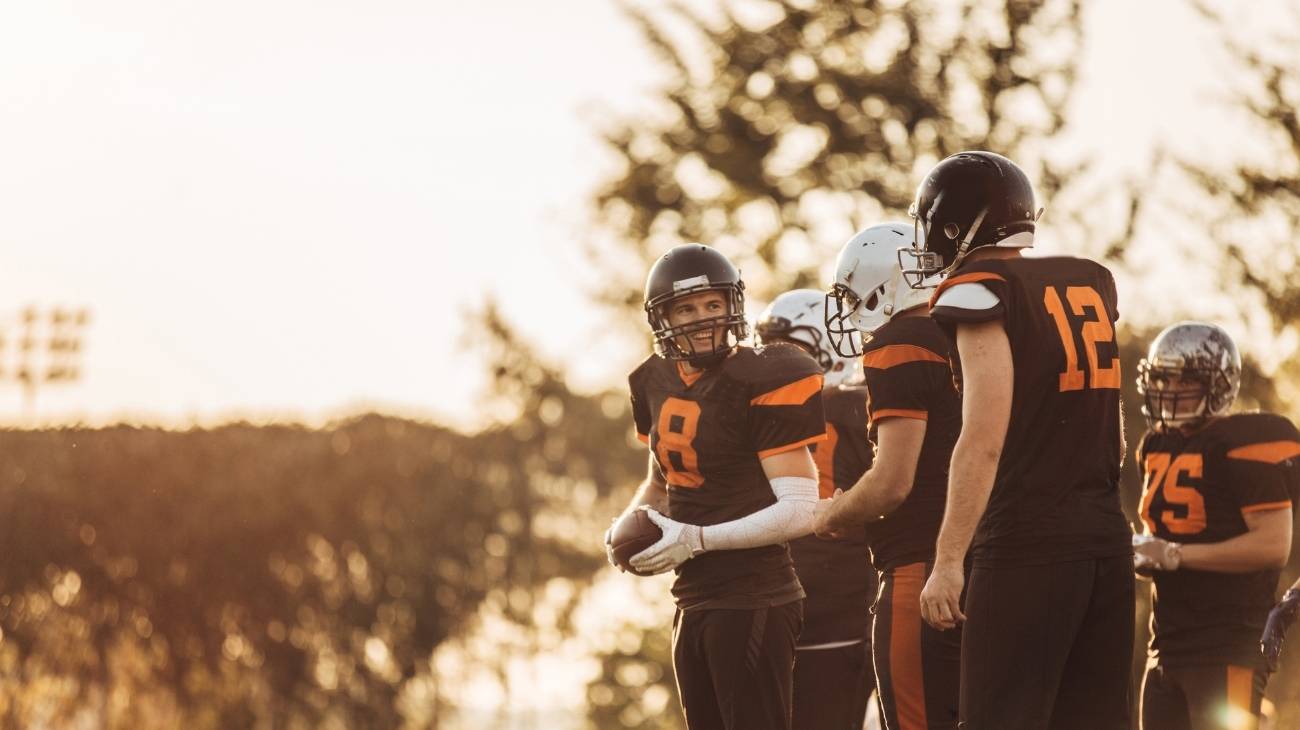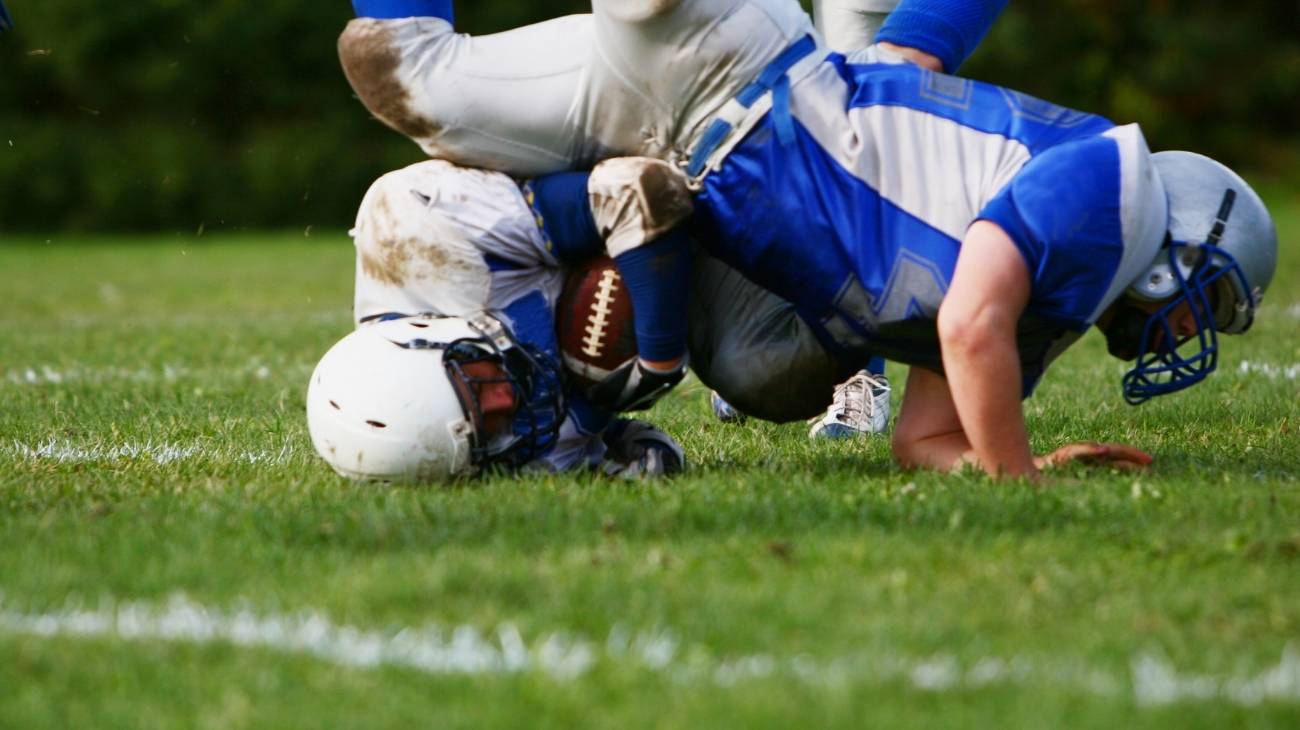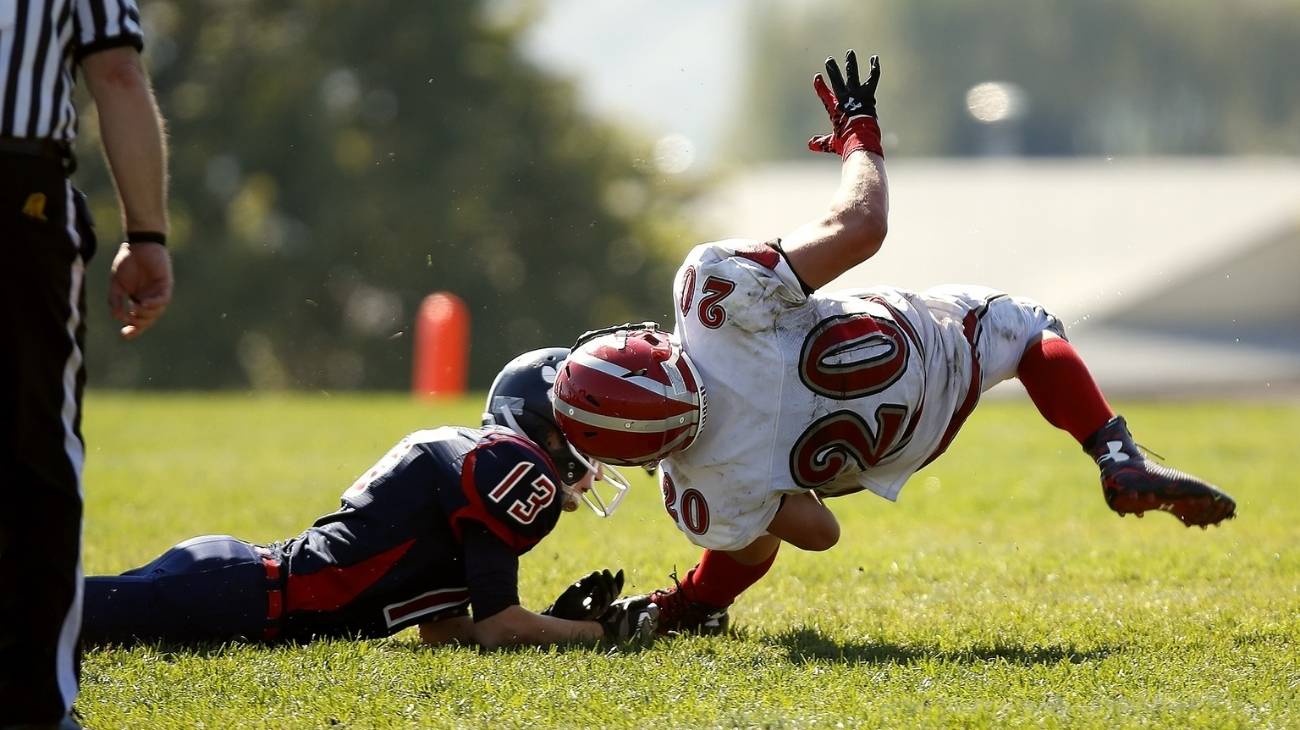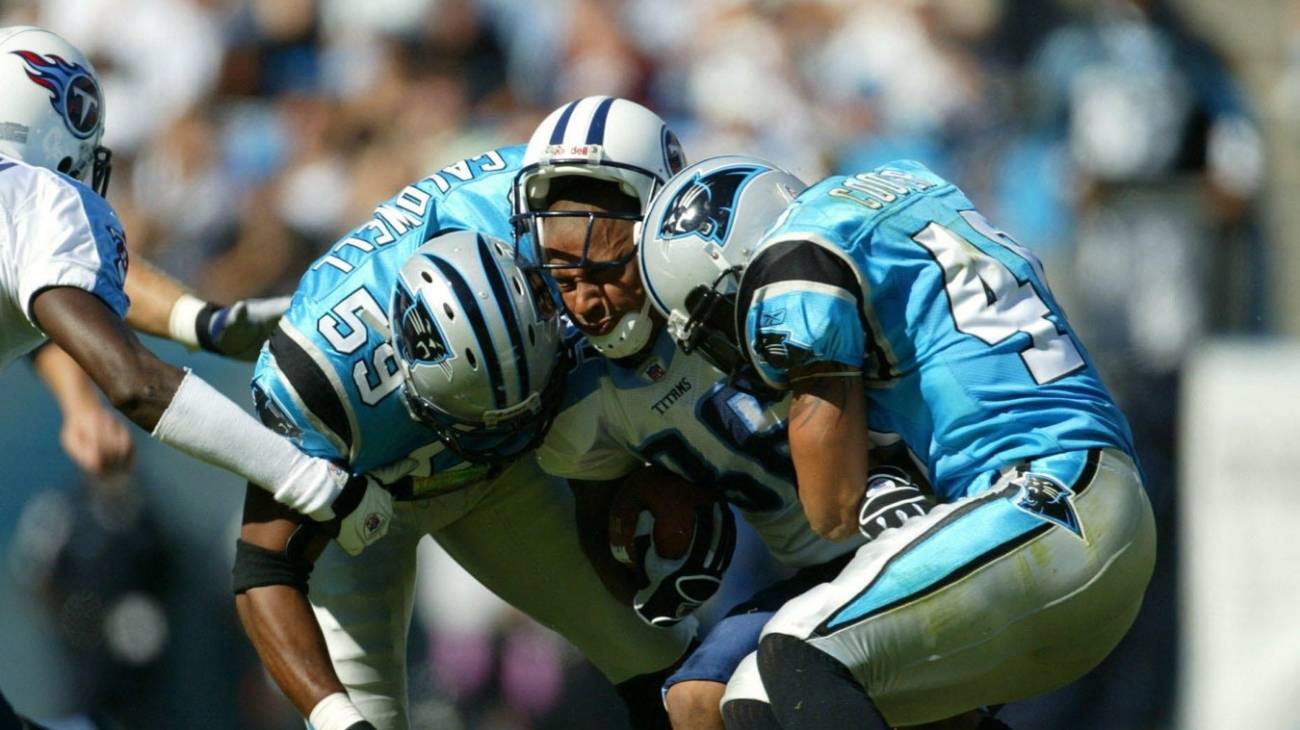At the beginning of the 20th century, when football was beginning to resemble what we know today, neck and head injuries were quite frequent and with serious consequences on the health of the players. With the advancement of technology in the manufacture of helmets and pads, the injury rate decreased. However, these injuries are still possible.
Get to know the most common ailments and discomforts in the neck and head when we play football, learn how they originate and what you can do to avoid them. In addition, you will learn how to use the PRICE therapy as a form of first aid and we will show you a list of the most effective products on the market to recover from an injury.
What are the most common types of neck and skull injuries when playing football?
Over the seasons, players have adapted to new forms of general blocking and tackling. There are many ways a player could be injured, so you should know this list of the most common neck and head injuries.
Hyperlordosis
The spine has natural curvatures in both the cervical and lumbar areas, these curvatures are known as lordosis. And when the curvatures are excessive or irregular, they are called hyperlordosis.
This is a recurring condition in football players. In the spine there are vertebrae that are separated by the intervertebral discs, although they are united, in reality they are individual pieces whose functioning is perfectly synchronized.
Between these components, they provide mobility to the body, protect the nerves, counteract the effect of gravity and serve as anchorage for tissues such as muscles and ligaments of the back. In short, the vertebrae are sensitive to the constant hits and tackles in football.
How does the neck lose its curvature? Generally age is the main cause, but the intensity of the sport causes the discs to move and there is an increase in cervical curvature at an early age, which leaves pain and stiffness in the neck.
Herniated discs
Herniated discs are a multifactorial pathology, meaning that wear and tear and repetitive movements cause them, but so do hard blows. And although football players are highly protected, a tackle can generate more than 400 kilos of force and this generates damage to the cervical.
A hernia is the displacement of the intervertebral disc that is in the middle of two vertebrae. It is a softer structure, which has a nucleus, and when it is displaced it causes severe pain in the back of the neck.
These herniations also consist of the deformation and total damage of the disc itself, and in these cases, surgery must be performed to remove the damaged disc and replace it with a biocompatible substitute, which may be made of synthetic material or animal parts.
After each game, you should be aware of pain in the shoulders and arms, numbness and tingling in the neck and weakness in the neck movement. If the displacement is mild, there are often no clear symptoms to indicate a herniated disc.
Cervical sprain
This is a very common injury in traffic accidents, but in football it is also possible to have this ailment. It is generated when the player receives a strong attack from behind or from the side. This discomfort is also known as "whiplash".
In fact, it is the tearing of one or more ligaments that are attached to the vertebrae and discs. The severity of the injury cannot be known at first glance. Only the intensity of the pain and the stiffness in the neck will give an account of the real damage received at the time of the incident. Whenever there is pain in the neck due to trauma, it is advisable to leave the field and perform a thorough examination.
From the moment of impact, the player may feel headache, muscle contractions and sporadic dizziness. Specialists recommend an X-ray as soon as possible to determine if the damage is more serious than thought.
Will there always be all these symptoms? No, everything will depend on the force of the impact, sometimes the pain is not radiated in the head, but there should always be a thorough examination by a traumatologist to be sure that the injury will pass in a few days.
Brain contusions
When a blow to the head occurs in football, it is usually severe. That is why since the 40's the use of helmets in the NFL is mandatory, by then these were made of leather, but now they are composed of a resistant plastic on the outside, with a thick padding on the inside.
Although the helmets withstand up to 8 G-forces, concussions are possible due to the force of the tackle on each play. On each hit, the brain hits twice: the first time when the head hits the case and the second time when the brain hits the skull, remember that the brain mass is not fixed inside.
In a contusion there is damage to the functioning of the brain, an alteration in its structure. What is sometimes necessary surgical intervention, unlike the concussion in which there is dizziness and pain, but the brain structure is not compromised. During a concussion there is hemorrhage and swelling of the brain mass, which is why these solid helmets are made, but even a strong tackle can cause the player to drop this important protection.
Chronic traumatic encephalopathy
Safety in this sport has always been a subject of discussion and study, the NFL determined that in a single season 99% of its players end up with some kind of injury (mild and severe) to their heads due to the constant blows they receive in the games.
One of these injuries is Chronic Traumatic Encephalopathy (CTE), which consists of intense and repeated pain due to the players' repeated shocks to their upper extremities. The negative point is that the only accurate diagnosis can be made at autopsy. It is a degenerative disease that begins to affect the functioning of the brain, so it is considered a chronic injury because it occurs over the years and hundreds of blows received in the head.
Post concussion syndromes and second impact syndrome are a consequence of the constant impacts of these players. If you didn't know, collisions between players are more damaging than falls on the field.
Best products for the recovery of cervical injuries in football
Bestseller
-
Acupressure Mat and Pillow (Black/Gray)
$49.95 -
Acupressure Mat and Pillow (Green/Navy)
$49.95 -
Acupressure Mat and Pillow (Pink/Bordeaux)
$49.95 -
Acupressure Pillow (Black/Gray)
$29.46 -
Acupressure Pillow (Green/Navy)
$29.46 -
Acupressure Pillow (Pink/Bordeaux)
$29.46 -
Ice Massage Roller Ball (Black)
$39.95 -
Ice Massage Roller Ball (Green)
$39.95 -
Ice Massage Roller Ball (Pink)
$39.95 -
Microwave Heating Pad for Neck & Shoulder Pain Relief (Hearts)
$24.95 -
Microwave Heating Pad for Neck & Shoulder Pain Relief (Oxford)
$24.95 -
Microwave Heating Pad for Neck & Shoulder Pain Relief (Sport)
$24.95 -
Microwave Heating Pad for Neck Pain Relief (Hearts)
$19.95 -
Microwave Heating Pad for Neck Pain Relief (Oxford)
$19.95 -
Microwave Heating Pad for Neck Pain Relief (Sport)
$19.95 -
Microwaveable Heating Pad for Pain Relief (Hearts)
$19.95 -
Microwaveable Heating Pad for Pain Relief (Oxford)
$19.95 -
Microwaveable Heating Pad for Pain Relief (Sport)
$19.95 -
Shoulder Support Brace (Black)
$24.95 -
Shoulder Support Brace (Green)
$24.95 -
Shoulder Support Brace (Pink)
$24.95 -
Trigger Point Massage Stick (Black)
$14.95 -
Trigger Point Massage Stick (Green)
$14.95 -
Trigger Point Massage Stick (Pink)
$14.95
How to apply the RICE therapy to treat head and neck injuries in football players?
The PRICE therapy is a set of steps to be followed and that when combined they generate relief in the discomfort associated with a mild injury, i.e. discomfort in soft tissues such as muscles, tendons and ligaments. PRICE is an update of the initial therapy called RICE.
- Protection: The best way to protect the cervical area is with a neck brace and try to minimize movement in the neck that can cause further pain and inflammation. Neck injuries are very serious, so you should not overlook any symptoms.
- Rest: A good rest should begin from the instant of injury and extend up to 72 hours to be considered a mild injury. In the case of whiplash, if the pain continues after three days, then you should seek the support of a specialist.
- Ice: If you want to quickly reduce pain and inflammation, ice will be a good ally as long as you respect some rules of use: You should not place ice directly on the skin and you should apply cold for a maximum of 20 minutes, then it is important to offer a rest of another 10 minutes.
- Compression: It is not recommended to offer any type of compression on the neck, unless indicated by a specialist. The only valid way to generate protection and reduce mobility in the neck is with a neck brace and this accessory should be suggested by a specialist.
- Elevation: This is a step that is almost entirely omitted, due to the fact that the neck and head are above the level of the heart. However, when the person is lying down it is important to slightly increase the inclination of its position to favor the effect of gravity on blood circulation.
References
- McIntosh, A. S., & McCrory, P. (2005). Preventing head and neck injury. British Journal of Sports Medicine, 39(6), 314-318. https://bjsm.bmj.com/content/39/6/314.short
- Jin, X., Feng, Z., Mika, V., Li, H., Viano, D. C., & Yang, K. H. (2017). The role of neck muscle activities on the risk of mild traumatic brain injury in American football. Journal of biomechanical engineering, 139(10). https://asmedigitalcollection.asme.org/biomechanical/article-abstract/139/10/101002/371344/The-Role-of-Neck-Muscle-Activities-on-the-Risk-of
- Torg, J. S., Guille, J. T., & Jaffe, S. (2002). Injuries to the cervical spine in American football players. JBJS, 84(1), 112-122. https://journals.lww.com/jbjsjournal/Citation/2002/01000/Injuries_to_the_Cervical_Spine_in_American.18.aspx
- Walton, D. M., Pretty, J., MacDermid, J. C., & Teasell, R. W. (2009). Risk factors for persistent problems following whiplash injury: results of a systematic review and meta-analysis. journal of orthopaedic & sports physical therapy, 39(5), 334-350. https://www.jospt.org/doi/full/10.2519/jospt.2009.2765
- Freeman, M. D., Croft, A. C., Rossignol, A. M., Centeno, C. J., & Elkins, W. L. (2006). Chronic neck pain and whiplash: a case-control study of the relationship between acute whiplash injuries and chronic neck pain. Pain Research and Management, 11(2), 79-83. https://www.hindawi.com/journals/prm/2006/304673/
- Saal, J. A. (1991). Common American football injuries. Sports medicine, 12, 132-147. https://link.springer.com/article/10.2165/00007256-199112020-00005
- Kelly, B. T., Barnes, R. P., Powell, J. W., & Warren, R. F. (2004). Shoulder injuries to quarterbacks in the national football league. The American journal of sports medicine, 32(2), 328-331. https://journals.sagepub.com/doi/abs/10.1177/0363546503261737
- Pellman, E. J., Viano, D. C., Casson, I. R., Arfken, C., & Powell, J. (2004). Concussion in professional football: Injuries involving 7 or more days out—Part 5. Neurosurgery, 55(5), 1100-1119. https://journals.lww.com/neurosurgery/Abstract/2004/11000/Concussion_in_Professional_Football__Injuries.14.aspx
- Bradley, J. P., Klimkiewicz, J. J., Rytel, M. J., & Powell, J. W. (2002). Anterior cruciate ligament injuries in the National Football League: epidemiology and current treatment trends among team physicians. Arthroscopy: The Journal of Arthroscopic & Related Surgery, 18(5), 502-509. https://www.sciencedirect.com/science/article/abs/pii/S0749806302348588
- Brophy, R. H., Wright, R. W., Powell, J. W., & Matava, M. J. (2010). Injuries to kickers in American football: the National Football League experience. The American journal of sports medicine, 38(6), 1166-1173. https://journals.sagepub.com/doi/abs/10.1177/0363546509357836








































